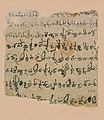Tocharian languages facts for kids
Quick facts for kids Tocharian |
||||
|---|---|---|---|---|

Tocharian B manuscript, c. 7th century AD
|
||||
| Native to | Agni, Kucha, Turfan and Krorän | |||
| Region | Tarim Basin | |||
| Ethnicity | Tocharians | |||
| Extinct | 9th century AD | |||
| Language family |
Indo-European
|
|||
| Dialects |
Agnean (Tocharian A)
Kuchean (Tocharian B)
Kroränian (Tocharian C)
|
|||
| Writing system |
|
|||
| Linguist List | xto Tocharian A | |||
| txb Tocharian B | ||||
 |
||||
|
||||
The Tocharian languages were a group of languages that are no longer spoken today. They belonged to the Indo-European languages family. This is a huge family of languages spoken by many people around the world.
Tocharian languages were spoken in a place called the Tarim Basin. This area is now part of Xinjiang, China. People used these languages from about the 5th century to the 8th century AD. We know about three main Tocharian languages: Tocharian A, Tocharian B, and Tocharian C.
Contents
What Are Tocharian Languages?
Tocharian languages are a special part of the Indo-European languages family. This family includes languages like English, Spanish, Hindi, and Russian. Tocharian languages are unique because they were spoken very far east compared to other Indo-European languages.
These languages are now extinct. This means no one speaks them as their main language anymore. We know about them from old writings found in the Tarim Basin.
Where Were They Spoken?
The Tocharian languages were spoken in cities along the northern edge of the Tarim Basin. This area was an important stop on the ancient Silk Road. The Silk Road was a famous trade route that connected China with Europe.
The main cities where Tocharian was spoken were Karasahr (where Tocharian A was used) and Kucha (where Tocharian B was used). Another language, Tocharian C, was found in a place called Krorän.
When Were They Used?
Most of the writings we have from Tocharian languages are from the 5th century to the 8th century AD. These writings include many different texts. They tell us about daily life, religious stories, and even poems.
The languages slowly died out around the 9th century AD. This happened when other groups of people, like the Uyghurs, moved into the area. They brought their own languages, which became more common.
Types of Tocharian Languages
There were three main types of Tocharian languages. Each one was a bit different and spoken in a specific area.
Tocharian A (Agnean)
Tocharian A was also called Agnean. It was mainly used in the area around the city of Karasahr. This language was mostly used for religious texts. It seems it was not used for everyday talking as much as Tocharian B.
Tocharian B (Kuchean)
Tocharian B was also known as Kuchean. It was spoken in the region around Kucha. This language was used for many things. People wrote about daily life, business, and religion in Tocharian B. It was probably the most widely spoken of the three.
Tocharian C (Kroränian)
Tocharian C is the least known of the three. It was found in the area of Krorän. We only have a few short texts in this language. This makes it harder for experts to learn much about it.
How Do We Know About Them?
We know about Tocharian languages because of old manuscripts. These are like ancient books or documents. They were found in the desert regions of the Tarim Basin. The dry climate helped to preserve them for hundreds of years.
Most of these writings are on palm leaves or paper. They are written using a special alphabet called the Brahmi script. This script came from India.
Images for kids
-
The geographical spread of Indo-European languages
-
Tocharian royal family (King, Queen and young blond-hair Prince), Kizil, Cave 17 (entrance wall, lower left panel). Hermitage Museum.
-
Tocharian B inscription from the Kizil Caves, in the Tocharian version of the Brahmi script, reading:𑀲𑁂𑀧𑀜𑀓𑁆𑀢𑁂 𑀲𑀡𑁆𑀓𑁂𑀢𑀯𑀝𑁆𑀲𑁂 𑀱𑀭𑁆𑀲 𑀧𑀧𑁃𑀬𑁆𑀓𑁅(Traditional Ashokan Brahmi)Se pañäkte saṅketavattse ṣarsa papaiykau"This Buddha, by Sanketava's hand, was painted".
-
Wooden tablet with an inscription showing Tocharian B in its Brahmic form. Kucha, Xinjiang, 5th–8th century (Tokyo National Museum)
-
Ambassador from Kucha (龜茲國 Qiuci-guo) at the Chinese Tang dynasty court. Wanghuitu (王会图), circa 650 CE
See also
 In Spanish: Lenguas tocarias para niños
In Spanish: Lenguas tocarias para niños






